Advertisements
Advertisements
Question
If Meselson and Stahl's experiment is continued for four generations in bacteria, the ratio of `15_N/15_N:15_N/14_N:14_N/14_N` containing DNA in the fourth generation would be ______.
Options
0 : 1 : 7
0 : 1 : 3
1 : 4 : 0
1 : 1 : 0
Solution
If Meselson and Stahl's experiment is continued for four generations in bacteria, the ratio of `15_N/15_N:15_N/14_N:14_N/14_N` containing DNA in the fourth generation would be 0 : 1 : 7.
APPEARS IN
RELATED QUESTIONS
Describe Meselson and Stahl’s experiment that was carried in 1958 on E.Coli. Write the conclusion they arrived at after the experiment.
Why does DNA replication occur within such "forks"?
Name two enzymes involved in the process of DNA replication along with their properties.
Escherichia coli fully labelled with N15 is allowed to grow in N14 medium. The two strands of DNA molecule of the first generation bacteria have ______.
Experimental material in the study of DNA replication has been ______.
Okazaki fragments are seen during ______.
First experimental proof for semi-conservative DNA replication was shown in ______.
If Meselson and Stahl's experiment is continued for sixth generations in bacteria, the ratio of Heavy strands 15N/15N: Hybrid15N/14N: light 14N/14N containing DNA in the sixth generation would be ______
The origin of replication of DNA in E. coli is shown below, Identify the labelled parts (i),(ii), (iii), and (iv)

The DNA molecules of the same size were extracted from E. coli and Plasmodium vivax. It was discovered that both the DNA molecules had one target site each for the restriction enzyme Hind II. After being digested with Hind II, the DNA fragments were subjected to gel electrophoresis.
With reference to the diagram given below, identify the lanes that represent the DNA fragments of E. coli and Plasmodium vivax respectively. Justify your answer with a reason for each.

